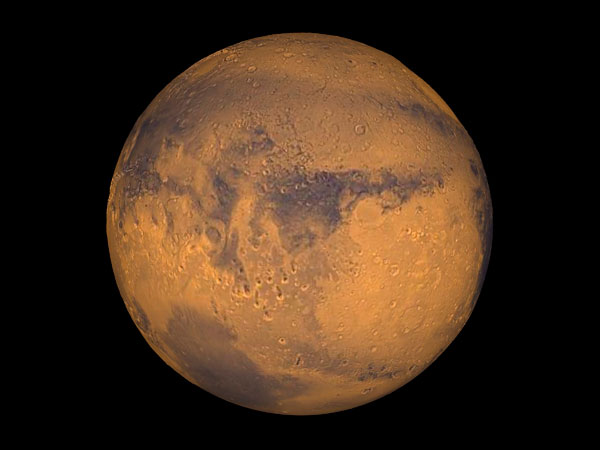Evidence found of summertime water flows on Mars: study
Updated: 2015-09-28 23:30
(Agencies)
|
||||||||
 |
|
The planet Mars showing Terra Meridiani is seen in an undated NASA image. NASA will announce a major science finding from the agency's ongoing exploration of Mars during a news briefing September 28 in Washington.[Photo/Agencies] |
CAPE CANAVERAL, Fla - Scientists have found the first evidence that briny water may flow on the surface of Mars during the planet's summer months, a paper published on Monday showed.
Although the source and the chemistry of the water is unknown, the discovery could affect thinking about whether the planet that is most like Earth in the solar system could support present day microbial life.
Scientists developed a new technique to analyze chemical maps of the Martian surface obtained by NASA's Mars Reconnaissance Orbiter spacecraft.
They found telltale fingerprints of salts that form only in the presence of water in narrow channels cut into cliff walls throughout the planet's equatorial region.
The slopes, first reported in 2011, appear during the warm summer months on Mars, then vanish when the temperatures drop.
Scientists suspected the streaks, known as recurring slope lineae, or RSL, were cut by flowing water, but had previously been unable to make the measurements.
"I thought there was no hope," Lujendra Ojha, a graduate student at Georgia Institute of Technology and lead author of a paper in this week's issue of the journal Nature Geoscience, told Reuters.
Mars Reconnaissance Orbiter makes its measurements during the hottest part of the Martian day, so scientists believed any traces of water, or fingerprints from hydrated minerals, would have evaporated.
Also, the chemical-sensing instrument on the orbiting spacecraft cannot home in on details as small as the narrow streaks, which typically are less than 16 feet (5 meters) wide.
But Ojha and colleagues created a computer program that could scrutinize individual pixels. That data was then correlated with high-resolution images of the streaks. Scientists concentrated on the widest streaks and came up with a 100 percent match between their locations and detections of hydrated salts.
"We're not claiming that we found ... evidence of liquid water. We found hydrated salts," Ojha said.
Still, that was enough for NASA, which declared a "Mars mystery solved," in a press advisory. A press conference on it was planned for 11:30 a.m. EDT/1530 GMT on Monday.
"It's a little bit over-the-top announcement by NASA," Ojha said. "There's so many mysteries to be solved about RSL."
The discovery "confirms that water is playing a role in these features," added Alfred McEwen, a planetary scientist with Arizona State University. "We don't know that it's coming from the subsurface. It could come from the atmosphere.'
Whatever the water's source, the prospect of liquid water, even seasonally, raises the intriguing prospect that Mars, which is presumed to be a cold and dead planet, could support life today.
Much more information about the water's chemistry, however, would be needed before scientists could make that assessment, McEwen added.
"It's not necessarily habitable just because it's water - at least to terrestrial organisms," he said.
NASA's ongoing Mars rover Curiosity has found evidence that Mars had all the ingredients and suitable habitats for microbial life to exist at some point in its past.
Scientists have been trying to figure out how it transformed from a warm, wet and likely Earth-like planet early in its history into the cold, dry desert that exists today.
Billions of years ago, Mars, which lacks a protective, global magnetic field, lost much of its atmosphere. Several initiatives are under way to determine how much of the planet's water was stripped away and how much remains locked in ice in underground reservoirs.
- Mars test parachute failed soon after inflating: NASA
- India's Mars mission completes six months in space
- China at technical preparation stage for Mars, asteroid exploration
- Four Chinese among top 100 candidates for one-way trip to Mars
- China looks toward Mars as rover model debuts
- Crowd trouble mars Croatia draw with Italy
- Typhoon Dujuan makes landfall, disrupts traffic
- China announces contribution to EU's 315 billion-euro investment plan
- Chinese population may face sharp drop from 2017
- Plan in pipeline to save groundwater
- Forbidden City visitor cap to stay during holiday
- Watch your behavior overseas, Chinese tourists told
- Evidence found of summertime water flows on Mars: study
- Dogs surf in contest in California
- France launches air strikes against Islamic State in Syria
- LatAm experts praise Xi on yuan, globalization
- Women's rights are human rights, German chancellor says
- Hajj death toll rises to 769, Iran denounces 'crime'
-
 China's first lady visits Juilliard School
China's first lady visits Juilliard School -
 China's first lady unveils stamp honoring disabled
China's first lady unveils stamp honoring disabled -
 Xi makes four-point proposal on promoting women's rights
Xi makes four-point proposal on promoting women's rights -
 China gifts the UN 'Zun of Peace' for 70th anniversary
China gifts the UN 'Zun of Peace' for 70th anniversary -
 Xi calls for equitable, open, all-round development
Xi calls for equitable, open, all-round development 
 First Lady Peng delivers speech in English at UN
First Lady Peng delivers speech in English at UN
 Three Xi-Obama meetings: From casual to black tie
Three Xi-Obama meetings: From casual to black tie
 Xi pledges $2 billion to help developing countries
Xi pledges $2 billion to help developing countries
Most Viewed
Editor's Picks

|

|

|

|

|

|
Today's Top News
Xi pledges $2 billion to help developing countries
Young people from US look forward to Xi's state visit: Survey
US to accept more refugees than planned
Li calls on State-owned firms to tap more global markets
Apple's iOS App Store suffers first major attack
Japan enacts new security laws to overturn postwar pacifism
Court catalogs schools' violent crimes
'Beauty of Beijing's alleys akin to a wise, old person'
US Weekly

|

|







